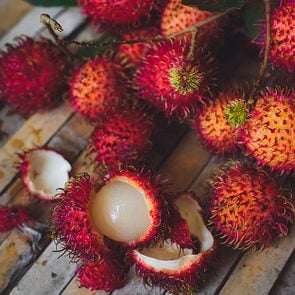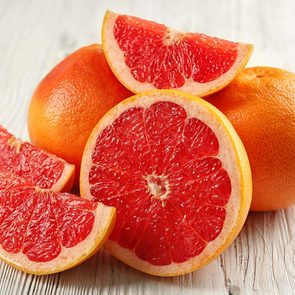Baobab Fruit: 10 Things Nutritionists Need You to Know
Updated: May 24, 2021
Baobab powder is full of antioxidants, vitamins, minerals, and packed with fiber. Learn about its health benefits and how to eat it.
What is baobab?
You may be familiar with the baobab tree, thanks to the animated film Madagascar.
These curious trees may be native to this island, but they also grow in many regions within the African continent,
Baobab fruit grows in long, green velvety pods that hang off the branches of the baobab tree.
The baobab fruit is unique: It dries naturally on the branch—it’s the only fruit in the world to do so.
If you’ve never heard of the baobab tree fruit, you’re not the only one since it’s not readily available in grocery stores.
However, baobab powder is beginning to appear on supermarket shelves as people uncover its medicinal properties and health benefits
“Baobab contains many nutrients—fiber, antioxidants, and vitamins and minerals like vitamins B, C, iron, potassium, magnesium, and calcium,” says Danielle Gaffen, registered dietitian nutritionist and nutrition consultant based in San Diego, California.

Where does the baobab tree grow?
Baobab trees, part of the Adansonia genus, may be associated with the island of Madagascar as well as with the continent of Africa but these “trees of life”—their nickname, also have different varieties that grow in India, Ceylon, Australia, and the Middle East.
The fruit is becoming more widely known and the powder is being exported to other regions of the world—though increased demand could become an environmental issue since a newly planted tree can take 25 years before bearing fruit. The trees can live 1,000 years or more.
Also: Baobab trees aren’t grown on plantations—they grow in the wild or are community-owned.
How do people use it?
The baobab pod, or fruit, are green while they are growing and take around six months before they’re ready to be harvested.
Pickers can tell when a pod is ready to harvest because its skin color changes from green to brown.
Once picked from the tree, the pods are cracked open and the white pulp is separated from the seeds, leaving dry fruit chunks that are then ground and milled into a fine powder.
But the fruit of the baobab isn’t the only part locals harvest: They use the leaves, seeds, and bark as traditional remedies to treat a variety of conditions, such as malaria and dysentery.
Baobab nutrition facts
“Baobab is a good source of antioxidants, vitamin C, calcium, potassium, and fiber,” says Holly Klamer, Michigan-based registered dietitian and nutrition consultant.
Here are the nutritional benefits and recommended daily values (DV) of two tablespoons (20 grams) of baobab powder:
Calories: 50
Protein: .7 g (1 percent DV)
Carbs: 16 grams (6 percent DV)
Fat: 0 g
Fiber: 9 g (32 percent DV)
Vitamin C: 34.6 mg (38 percent DV)
Vitamin B6: .483 mg (37 percent DV)
Calcium: 68.40 mg (5 percent DV)
Iron: 1.68 mg (9 percent DV)
Magnesium: 31.60 mg (8 percent DV)
Niacin: 3.99 mg (25 percent DV)
Potassium: 438 mg (9 percent DV)
Potential health benefits of baobab
Because baobab is high in fiber, it can help with weight control and keep your blood sugar levels steady—and those are just a couple of the fruit’s potential benefits.
Helps you feel fuller longer
Fiber is important for keeping the body healthy as well as feeling satiated after a meal.
“Baobab is high in fiber. There has been some preliminary research indicating that the fiber and polyphenols in baobab (extract) may reduce feelings of hunger, keeping you full longer,” explains Gaffen. “The fiber will also promote digestive health too!”
Fiber does not only help with feeling satiated, there are an array of benefits when you consume sufficient fiber in a balanced diet.
“Higher fiber levels are linked to a healthy digestive tract, helping to prevent constipation and benefitting the good-for-you bacteria in our gut’s microbiome”, explains Gaffen.
Aids with blood sugar control
Keeping your blood sugar levels steady is important—steep spikes and dips can lead to overeating and is a risk factor for type 2 diabetes.
“In a few research studies which incorporated baobab in white bread dough, participants experienced more gradual rises in blood sugar levels compared to white bread alone,” says Gaffen.
“This may be due to the fiber levels in baobab; fiber helps prevent large blood sugar spikes.”
Inflammation
Baobab may reduce inflammation, which has been linked to numerous chronic conditions like heart disease, digestive troubles, and certain types of arthritis.
“There is some preliminary research indicating that baobab could help lower inflammation (likely due to the antioxidants and polyphenols found within this fruit),” says Gaffen.
So far, studies have only been done on animals so “more research is needed to see how baobab may affect inflammation in humans,” explains Gaffen.
Good for the skin
Baobab oil carries some promise as a moisturizer: “When used topically in the oil form, it is a moisturizer which can soften and hydrate the skin as well as reduce inflammation,” explains Jennifer Trent, MD, Florida-based board-certified dermatologist.
In a few studies, baobab oil has helped ease acne, eczema, and dandruff, says Dr. Trent.
But it’s important to know that more information is needed—and it may not be good for everyone, especially since the oil can block pores and may produce blackheads or other ailments, Dr. Trent explains.
Concerns or risks
Overall, baobab is safe to consume but it does contain antinutrients—they can limit or lower absorption of different nutrients.
“Baobab contains oxalic acid, phytates, and tannins—all three of which can reduce the body’s ability to absorb certain nutrients,” explains Gaffen. “Also, cyclopropenoid fatty acids found in baobab oil may contribute to health problems.”
In general, antinutrients aren’t something to be too concerned about.
“For most healthy people, the amounts of these nutrients are so small that they shouldn’t be an issue, especially if a person is consuming a balanced, healthful diet, says Gaffen.
“Additionally, some of these antinutrients are reduced during processing.”
Baobab does not pose an issue for most people, but if you’re thinking about adding this ingredient to your diet, you may want to consult your doctor in advance.
“If a person has a serious health condition, is pregnant, or breastfeeding, it’s worthwhile to speak to your doctor before consuming baobab,” says Gaffen.
How do you eat baobab powder?
Because the fruit is not readily available or easy to find, one of the best ways to try baobab is in the form of baobab powder.
You can add it to an array of beverages, such as tea, juice, or water to add some flavor and tang as well as add additional nutrients.
“Baobab powder can be added to water or other liquids and provides a slightly citrus, sweet flavor,” says Klamer.
You can also sprinkle some on your yogurt and mix it in. Baobab powder is versatile and you can “use it to thicken smoothies and incorporate it into ice cream or other sweets,” says Klamer.
But it’s not only for smoothies. “The powder can also be incorporated into baked goods like bread dough for an extra boost in antioxidants,” explains Gaffen.
Next, here’s everything you need to know about dragon fruit benefits.




















